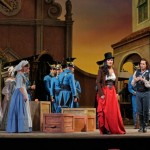By Rebecca Schmid
The socially aware agenda of the Komische Oper’s new Intendant Barrie Kosky has been ruffling the feathers of Berliners months before he officially took over this season, not least with the decision to end the house tradition of performing operas exclusively in the German language. His emphasis on cultural pluralism aside, the program so far should assuage any fears that the native Australian will create a rupture with the opera’s hallowed emphasis on reinventing opera for contemporary audiences. Following a 12-hour Monteverdi trilogy as rescored by Elena Kats-Chernin and staged by Kosky, the intendant has unveiled the world premiere of Olga Neuwirth’s American Lulu, a shortened, updated version of Berg’s incompleted last opera.
It is either ironic or a sign of historic progress that Berlin, where Nazi politics once thwarted a full staging of the work, has mounted the second new Lulu in less than a year. The Staatsoper presented the work with a recomposed third act by David Robert Coleman last spring when a new production by Andrea Breth made it legally impossible to use the standard reconstruction by Friedrich Cerha. Almost foreshadowing Neuwirth, Coleman drew upon the jazz band of the First Act for his orchestration, thinning out textures to a chamber ensemble including marimba, steel drums cowbells, and banjo.
American Lulu (seen Oct.6) takes the thematicization of jazz a step further, setting out to reference Afro-American culture in everything from a steam blown organ ballad to a trumpet which emerges as a symbol for the blues singer, Eleanor (a curly haired, less feudal characterisation of Countess Geschwitz). Neuwirth resets passages of Berg’s original music to the first two acts for brass, woodwinds, a small set of strings, and percussion as well as electronic guitar and piano, in some places adding contours to Berg’s expressionist lines with the deeper timbres and expanding the sonic space with recorded sound. By contrast, her entirely original third act emerges as an unsure blend of quasi-minimalist textures, jazz-band brass, spectralist fades and raw, avant-garde string textures.
The English-language libretto is redevised in a similarly awkward fashion. The story begins and ends in an upscale New York apartment, traveling through New Orleans, where Lulu is living with the painter—here a photographer. Dr. Schön is instead Dr. Bloom, who kills Lulu’s lover by throwing ice at him. She flees with Bloom’s son, Jimmy (a stand-in for Alwa), becoming a high-class whore to a white banker and rebuffing the advances of Eleanor without remorse until she is killed by a stranger. Neuwirth also inserts an unidentifiable, pimp-like character named Clarence, who upbraids Lulu for being so “damn insatiable.” Recitations about black rights and other poetic musings emerge perplexingly through the speakers between acts.
The racially conscious goals of the production mostly came across as clichéd, but it had to its credit Marisol Montalvo in the role of Lulu, able to nail her high notes and move seamlessly into Sprechgesang as she cavorted in everything from lingerie to Brazilian tassels. Despite the high dose of eroticism, her dramatic portrayal did little to convey the danger of a femme fatale, which can also be attributed to the limited scope of her character in Neuwirth’s libretto and stilted direction by Kirill Serebrennikov. In the role of Eleanor, Della Miles performed with saucy poise, coaxing the orchestra of the Komische Oper into her R&B inflected grooves. The male roles were well-cast but not outstanding. Jacques-Greg Belobo gave a smooth-voiced delivery of Clarence, and Austrian baritone Claudio Otelli was an imposing Dr. Bloom. The bass Philipp Meierhöfer was in fine form as the Athlete, and Rolf Romei made for an earnest Jimmy, including when he cracked into the higher range.
German conductor Johannes Kalitzke balanced the score’s wide-ranging demands with a steady hand. Sets and costumes by Serebrennikov provided a stark backdrop for Neuwirth’s modern fantasy but ended tastelessly with a bloodied picture of a murdered Lulu. Conventional black-and-white video projections by Gonduras Jitomirksky similarly did little for a production whose progressive aspirations fail to match up with its artistic standards. Perhaps Lulu was never meant to be a vehicle for racial mobility after all.




Season of Concessions
October 11th, 2012By ANDREW POWELL
Published: October 11, 2012
MUNICH — Arts groups here present a restrained 2012–13 season facing pros and cons not always aligned with those in America. Funding, for instance, holds steady: city and state (Bavaria) play their part, as do local corporations Siemens, BMW, Audi, Allianz and Linde. Excellent pools of musicians, instrumental and vocal, fill the rosters of the choir, chamber orchestra, two opera companies, and five symphony orchestras discussed below. Audiences are large and regular; not incidentally, tickets for most events are affordably priced and come with free access to the train and bus network, covering residents in a 25-mile radius. The cons are few, but they matter. Creative torpor impedes the main orchestras, a reflection in part of more than one sadly filled music directorship. The Regietheater problem rages in Germany, defiling the worthiest efforts in opera. Atrocious acoustics plague Munich’s main concert hall, and one vintage venue is shut for now for a retrofit. All that said, the groups enter the new season with active agendas.
The 201-year-old Bavarian State Orchestra ventures six programs at its home, the National Theater. Mostly led by outgoing Generalmusikdirektor Kent Nagano, these Akademie concerts extend a tradition begun when the ensemble was new; their past features names like Strauss, Walter, Knappertsbusch, Krauss, Fricsay, Sawallisch and Kleiber. Under-rehearsal can hamper results, however, a consequence of the musicians’ hectic theater schedule; that the GMD does not always supply the last ounce of insight or much rhythmic thrust only accentuates the negative. Despite and still, one upcoming program has allure (April 8 and 9): the eloquent young Czech conductor Tomáš Hanus tackles Mahler’s kaleidoscopic Seventh Symphony.
Clarinetist Jörg Widmann’s seven-scene opera Babylon is a fall commission of Bavarian State Opera, Germany’s largest and busiest opera company. Nagano conducts as part of his last season, and Carlus Padrissa, who last year introduced a circus-tent Turandot, has been entrusted with the stage action (premiere Oct. 27). Several of the season’s productions will be streamed at no charge, starting with the Widmann on Nov. 3. Hanus follows his persuasive (and filmed) Rusalka of two years ago with a revival of Jenůfa (from March 6) as well as a Richard Jones production of Hänsel und Gretel (March 24). Constantinos Carydis, among the company’s other worthy conductors — and indeed winner of its first Carlos Kleiber Prize — is absent from the 2012–13 slate, effecting a sabbatical.
The smaller but versatile Staatstheater am Gärtnerplatz company enters a second season as refugee while its genial home undergoes construction work. Not all the substitute venues are ideal, but at the Cuvilliés Theater a Don Pasquale (premiere Oct. 25) should bring smiles: Franz Hawlata sings the title role, retired mezzo-soprano Brigitte Fassbaender (pictured with Intendant Josef Köpplinger and conductor Marco Comin) serves as régisseuse. This company labors under a mixed mandate, complementing Bavarian State Opera with Baroque and rare operas but also catering to a broad audience with operettas and musicals, at times amplified. Its orchestra copes gamely with the assortment, its singers less well.
Alexander Liebreich’s ongoing leadership of the MKO, a.k.a. Münchener Kammerorchester, has been yielding tidy ensemble and a crisp image for the group. Subscription concerts at MKO’s base, the Bayreuth-Festspielhaus-like Prinz-Regenten-Theater, habitually pair old and brand new, as on Oct. 18: Salvatore Sciarrino’s L’ideale lucente e le pagine rubate (2012) and Beethoven’s music for Egmont. Or Dec. 13: Ligeti’s Violin Concerto (old) and a Helena Winkelman piece jointly commissioned with Musica femina München.
Guest conductors, in contrast, are what enliven the Bavarian Radio Symphony Orchestra. Ranked highly for its expertise, and drilled weekly for clean-as-a-whistle broadcasts, the BRSO perseveres under monochrome directorship. Antonini, Rattle, Haitink, Muti, Harding, Gilbert, Robertson, Salonen, Chailly and Metzmacher are names implying color in upcoming programs. The season splits as usual between the modest shoebox Herkulessaal, part of Munich’s Residenz arts complex, and the city-operated, fan-cum-vineyard Gasteig hall, where only the intra-ensemble sound travels properly.
The adventurous Münchner Rundfunk-Orchester, a second BR (Bavarian Broadcasting) ensemble, devotes much of 2012–13 to oddball concert opera — Franz Lachner’s Catharina Cornaro? — when its exploratory funds would go further in orchestral music and better balance the BRSO. Welcome projects include a German-language take (May 3) on Hindemith’s FDR oratorio When Lilacs Last In the Dooryard Bloom’d, which may find its way to disc alongside this orchestra’s award-winning 2005 recording of Des Simplicius Simplicissimus Jugend by Hartmann (who wove the Whitman elegy into his own First Symphony). Playing standards have been high under Künstlerischer Leiter Ulf Schirmer. He stepped into the shoes of the late Marcello Viotti in 2006 and has more recently also assumed musical and managerial duties at Oper Leipzig.
Still under broadcasting auspices, the BR Chor supports both of the above orchestras. Alert, flexible singing places this group among Germany’s best large choirs, with perhaps only Leipzig’s MDR Chor ahead in precision. Certainly it draws the better Munich choristers, those disinclined to strip down to their underwear and strike mindless poses, as repeatedly required of their colleagues in local opera companies. Dutchman Peter Dijkstra is the affable artistic leader. BR Chor concerts this season, in the group’s own series, include Mozart’s C-Minor Mass (Nov. 24) and a well-cast Matthäus-Passion (Feb. 16), at the Prinz-Regenten-Theater and Herkulessaal respectively.
The Munich Philharmonic seemed to want to dive off a cliff three years ago when its management publicly bickered with its greatly-in-demand Generalmusikdirektor Christian Thielemann, effectively losing him, and just eight months later chose Lorin Maazel as his successor. (One tabloid reported Thielemann’s salary to be €800,000.) Those twin decisions are now home to roost, as the 82-year-old American unfurls his inaugural season. Maazel’s work ethic can only be admired, but he appeared artistically drained in interregnum Gasteig programs ten months ago — in music in which he long ago excelled, such as Debussy’s La Mer. This orchestra will gain the most if Munich ever does build a proper concert hall, as recently championed by Bavarian Minister for Science, Research and Art, Wolfgang Heubisch. As a city-run ensemble, it is today confined almost entirely to the problematic Gasteig.
Less glamorous, though certainly busy, the Münchner Symphoniker offers concert series at the acoustically preferable Prinz-Regenten-Theater and Herkulessaal. Georg Schmöhe is Chefdirigent and pianist Philippe Entremont serves as Ehrendirigent. In 2011 this orchestra undertook a long U.S. tour devoted to movie music. This season at home it offers an all-Beethoven program (Jan. 27 and 28) and a mostly Haydn evening (March 20) as part of a generally conservative lineup.
Photo © Christian Zach
Related posts:
Pintscher Conducts New Music
Mastersingers’ Depression
Gärtnerplatztheater Reopens
Gergiev, Munich’s Mistake
BR Chor’s St Matthew Passion
Tags: Alexander Liebreich, Bavarian Radio Symphony Orchestra, Bavarian State Opera, Bavarian State Orchestra, Bayerische Staatsoper, Bayerischer Rundfunk, Bayerisches Staatsorchester, BR Chor, Brigitte Fassbaender, Christian Thielemann, Commentary, Constantinos Carydis, Cuvilliés Theater, Don Pasquale, Gasteig, Herkulessaal, Jenůfa, Kent Nagano, Lorin Maazel, MKO, Münchener Kammerorchester, Münchner Philharmoniker, Münchner Rundfunk-Orchester, Münchner Symphoniker, Munich Philharmonic, National Theater, Nationaltheater, Peter Dijkstra, Prinz-Regenten-Theater, Staatstheater am Gärtnerplatz, Symphonie-Orchester des Bayerischen Rundfunks, Tomáš Hanus, Ulf Schirmer
Posted in Munich Times | Comments Closed